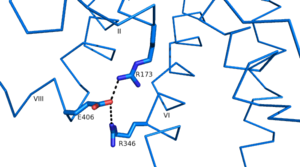Sandbox Reserved 1167
From Proteopedia
(Difference between revisions)
| Line 30: | Line 30: | ||
=== Unique components to the GPCR === | === Unique components to the GPCR === | ||
| + | |||
| + | As opposed to class A glucagon receptors which have a [https://en.wikipedia.org/wiki/Proline proline] kink, in all [https://en.wikipedia.org/wiki/Secretin_receptor_family secretin-like class B glucagon receptors] there is a [https://en.wikipedia.org/wiki/Glycine Glycine] at position 393 in Helix VII which allows for a <scene name='72/721537/Gly_393_helical_bend/1'>helical bend</scene>. This Glycine and therefore this helical bend is fully [https://en.wikipedia.org/wiki/Conserved_sequence conserved] in all secretin-like class B receptors and is an important part of the FQGxxVxxYCF [https://en.wikipedia.org/wiki/Sequence_motif motif]. | ||
| + | |||
| + | Another important structural component found in all secretin-like class B receptors are the two conserved [https://en.wikipedia.org/wiki/Salt_bridge_%28protein_and_supramolecular%29 salt bridges] found between [https://en.wikipedia.org/wiki/Arginine Arg] 346 and [https://en.wikipedia.org/wiki/Glutamic_acid Glu] 406 and Arg 173 and Glu 406 [[Image:Salt Bridge Interactions.png | 300 px|left|thumb|Glu 406 Salt Bridges]]. | ||
| + | Since there is no conservation of these residues in class A receptors these salt bridges are likely an important feature of secretin-like class B receptors. | ||
| + | |||
| + | [https://en.wikipedia.org/wiki/Disulfide Disulfide bond] | ||
| + | |||
| + | As a part of the interface stabilization between helices VI, V, and III, a class B specific [https://en.wikipedia.org/wiki/Hydrogen_bond hydrogen bond] occurs between [https://en.wikipedia.org/wiki/Asparagine N] 318 of Helix V and [https://en.wikipedia.org/wiki/Leucine L] 242 of Helix III. | ||
The 7tm region has a conserved disulfide bond at <scene name='72/721538/7tm_disulfide_bond/2'>Cys224-Cys294</scene> which helps to stabilize the 7tm fold. This bond is conserved among both Class A and Class B receptors. | The 7tm region has a conserved disulfide bond at <scene name='72/721538/7tm_disulfide_bond/2'>Cys224-Cys294</scene> which helps to stabilize the 7tm fold. This bond is conserved among both Class A and Class B receptors. | ||
Revision as of 17:51, 29 March 2016
| This Sandbox is Reserved from Jan 11 through August 12, 2016 for use in the course CH462 Central Metabolism taught by R. Jeremy Johnson at the Butler University, Indianapolis, USA. This reservation includes Sandbox Reserved 1160 through Sandbox Reserved 1184. |
To get started:
More help: Help:Editing |
Your Heading Here (maybe something like 'Structure')
| |||||||||||
References
- ↑ Hanson, R. M., Prilusky, J., Renjian, Z., Nakane, T. and Sussman, J. L. (2013), JSmol and the Next-Generation Web-Based Representation of 3D Molecular Structure as Applied to Proteopedia. Isr. J. Chem., 53:207-216. doi:http://dx.doi.org/10.1002/ijch.201300024
- ↑ Herraez A. Biomolecules in the computer: Jmol to the rescue. Biochem Mol Biol Educ. 2006 Jul;34(4):255-61. doi: 10.1002/bmb.2006.494034042644. PMID:21638687 doi:10.1002/bmb.2006.494034042644
- ↑ Yang L, Yang D, de Graaf C, Moeller A, West GM, Dharmarajan V, Wang C, Siu FY, Song G, Reedtz-Runge S, Pascal BD, Wu B, Potter CS, Zhou H, Griffin PR, Carragher B, Yang H, Wang MW, Stevens RC, Jiang H. Conformational states of the full-length glucagon receptor. Nat Commun. 2015 Jul 31;6:7859. doi: 10.1038/ncomms8859. PMID:26227798 doi:http://dx.doi.org/10.1038/ncomms8859
- ↑ PMID:PMC4321206

